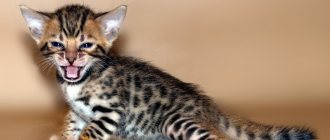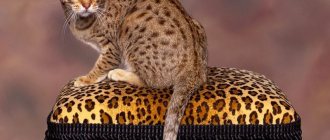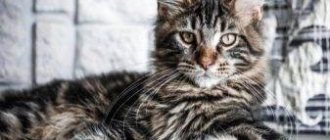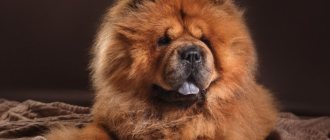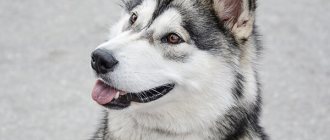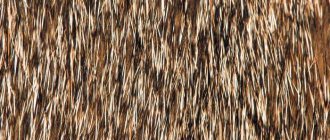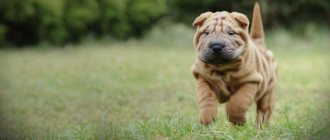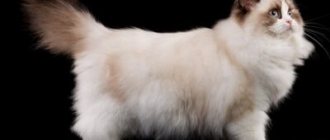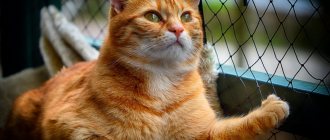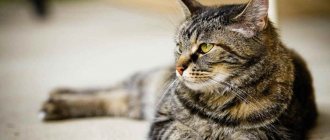Coat and color are a distinctive feature of the Bengal cat. Each pattern is individual: spots or stripes on a cat are like fingerprints on a person; no two are alike. Today, there are many colors of Bengal cats. The Snow Bengal stands out among all of them; it is even sometimes confused with another breed. Every cat lover dreams of having a little “leopard” at home.
Color standards
Outwardly, the Bengal cat always resembles its wild ancestors. On the muzzle there are contrasting dark stripes that resemble the letter “M” on the forehead. Light-colored whisker pads. The contours of the nose, lips and eyes are black or darker. Dark stripes on the neck, like a necklace, decorate it. There are often small stripes on the paws, but there may also be spots. The tail is also spotted or rosette, but its tip always remains black. All breeders strive to get as close as possible to the appearance of a wild cat. Therefore, the spotted belly and chest should preferably be lighter. It is not always possible to achieve such selective lightening - scientists still cannot definitively determine the gene that is responsible for this.
The colors of Bengals are distinguished by the color of the background and the type of pattern that is located on it. The most common are gold and silver backgrounds. There are snow bengals, among which there are lynx, mink, and sepia. The charcoal color is considered more rare. The blue color is also officially recognized.
Features of glitter in representatives of the black subspecies of the Bengal breed
Bengals with dark ash-colored or completely black coats are particularly suited to the famous elite glitter. On coats covered with a contrasting pattern, the shine, which turns into shine in bright light, is less noticeable, while on clean, unticked hair it covers the Bengal with sheer magic. The source of this phenomenon, to put it simply, is the presence of translucent and sometimes hollow hairs. When the rays hit them, they are refracted and produce not even shine, but radiance. Experts in the field of felinology explain the process with two interesting versions:
- Glitter is controlled by one of the recessive genes (which is why glitter does not always appear). When activated, it leads to a special grouping of pigment granules in the tips of the hairs. According to this hypothesis, the texture of the hair does not change.
- Proponents of another explanation believe that the source of the shine is the same recessive gene, which gives the coat a soft silkiness. In its homozygous manifestation, it makes the pigment granules dotted along the entire length of the hair. As a result, voids with tiny air bubbles appear inside. They are the ones who capture and transform the light flux.
It doesn't matter who ends up being more accurate in explaining the sparkle effect, but glitter is a delightful addition to the already chic appearance of charcoal and black Bengal cats.
Having set the goal of breeding a breed that would have the characteristic appearance of wild forest cats, but at the same time have a balanced, gentle character, man developed not hybrid, but cultivated varieties of Bengal cats. They differ from other purebred pets from the cat family not only in their temperament, but also in the variety of coat colors ranging from white to black, and most importantly, in completely unique patterns on their fur coats. Among them, the most exotic and so far rare are the charcoal and black bengals. Now that the study of the cat genome has taken advantage of identification using DNA tests, it is possible to more accurately control the coloring, tabby structure of cats, and the breeding of individual subspecies in one breed.
Pattern: spotted or marbled
Cat coloring is divided into two types:
- Spotted (from English spotted) or rosette (from English rosetted) pattern. In the first case, these are solid spots. In the second, the so-called sockets. The color inside the rosette should be darker than the background, which is completely or partially surrounded by a darker circle (closed and open rosette). The size of the spots or rosettes can range from small to large.
- Marble (from English marbled) pattern: represents various horizontal stripes. Circular or vertical marks are faults. It is more highly valued when the marble pattern of the Bengal contains three colors: the background shade, the pattern and its edging.
To distinguish the colors of Bengal cats, it is easier to use the table:
Interesting facts about the breed
- The appearance of the Bengal cat as a new breed owes its appearance to the kindness of the American woman Jean Mill. In 1961, while on a business trip to Bangkok, Jean bought a wild Bengal cheetah kitten. Their population was on the verge of extinction. Local residents exterminated animals for their valuable fur. The girl brought the “savage” home, mated with a domestic short-haired cat
- At the nursery, the kitten is given a birth certificate (passport) at birth. It indicates: breed, place of birth, full, long name, registration number, medical examination and vaccination data. Complete information about parents and grandparents up to the 4th generation is recorded.
- The Bengal breed is a smart, intelligent cat that can use the toilet on its own and flush the water from the tank.
Snow Bengal
Snow color is one of the rare ones. Snow Bengal kittens are divided into three groups depending on their genotype.
Links (Ben n 33) The background is represented by shades of cream or ivory. The pattern varies in tones of brown from light to dark. The head and paws are darker than the body. The tail is brown. These are the only snow bengals that are born completely white, and the pattern does not appear until they are one year old.
Mink (Ben n 32) They are often confused with the link color. The drawing from birth practically merges with the background and is hardly noticeable. The main difference is the eyes: their color varies from bright green to blue.
Sepia (Ben n 31) The color is lighter than golden, but darker than other snow Bengal cats. The difference between the background and the picture is small. The pads on the paws are brown, as is the tip of the tail. Eye colors include variations of green and yellow.
Coat and colors of long-haired Bengals (Cashmere)
Initially, the gene for long hair was considered an undesirable trait in the breed, but at the moment long-haired Bengals (Kashmirs) are already recognized by some international felinological systems.
The legitimacy of distinguishing Kashmir cats from the total number of Bengal cats has become a goal of many catteries. Breeders in the United States were keen to have these cats recognized as a variety of the Bengal breed due to their long hair - perhaps this is why TICA calls the breed Bengal Longhair. European breeders are trying to give Cashmere cats the status of a new, separate breed. So far, the term “Kashmir” is not widely used and is used mainly among specialists. At the same time, such cats are becoming increasingly popular; there are already nurseries of this breed in the USA, Europe (Germany, Poland, England), and Russia. In 2022, the first system to recognize long-haired Bengals as a separate breed was TICA. Today, Cashmere cats can take part in championships in the TICA, WOC, CFA, WCF systems.
Wool texture
Cashmere Bengals are a natural variation, so one cannot yet expect a uniform coat structure and length from its representatives. The length can be like that of a Turkish Angora cat or like that of a Maine Coon. But, unlike them, Kashmiris have no or almost no undercoat; their wool is closer in quality to the hair of a Bengal cat than to the wool of other long-haired breeds. The hairs are very thin, smooth, soft, pleasant to the touch - like cashmere fiber. This is where the name of the breed comes from - cashmere, which is preferred by breeders. In general, the quality of Kashmiri wool is the same as that of short-haired Bengals, the only difference being the length. This coat is easy to care for. Some believe that Kashmiri wool sheds less and is even hypoallergenic. This topic has not yet been fully studied, but definitely the molting period in these cats is almost invisible.
Colors
Long-haired Bengals have all the same colors as short-haired ones, including even the charcoal group. However, the Kashmiri does not have glitter, and the glitter is in no way related to the length of the coat: the kitten inherits this trait from its parents. The breeder’s task in this case is to select the appropriate pair.
In pattern, Cashmere cats are as beautiful and varied as short-haired Bengals. Their coats can be spotted or rosetted, or marbled, with dark curls contrasting with their light, silky fur.
How to tell if a kitten is Kashmiri
As adults, Kashmiris and Bengals are easy to distinguish from each other, but in infancy this is not always easy. When a litter is born, it is difficult to say which of the kittens will become long-haired if among the parents there is at least one short-haired one who carries the long-haired trait. And even if both parents are Bengals and carry the recessive gene for long hair, it is difficult to predict what their kittens' coat will look like. Most often, in one litter there are kittens with different hair lengths. Typically, the first signs of long hair appear between 4 and 12 weeks of age: you may see “pants” on the hind legs or long hairs in the ears.
Mixed bengal cat
Bengals are prohibited from crossing with other cat breeds. This is fraught with sick or completely non-viable offspring. However, some engage in this activity for commercial purposes. Such kittens can be found through frequent advertisements on the Internet. We warn you! Mixed breeds of the Bengal cat are not officially recognized. Such kittens do not belong to the Bengal breed. As a result, you can get a kitten that will not meet external standards, but also its character. Breeders carefully select affectionate and non-aggressive representatives. Otherwise, the genes may take over and you will end up with an uncontrollable animal. Long-haired mixed breed (cashmere bengal, silk bengal) is gaining popularity. The animal has a similar color. It is distinguished by a fluffy tail, a “collar”, and longer hair on the sides and back.
Author
Rudakova Anna
- Vice-President of the World Cat Federation (WCF), expert on all breeds, breeder of Oriental Shorthair, Siamese and Bengal breeds. Experience since 1997.
The Bengal cat breed is one of the most popular in the world. It ranks third after the British Shorthair and Maine Coon. (1)
Bengals are medium to large sized cats known for their richly colored, contrasting coats with bright spots or distinctive marbled patterns. Actually, this is the main distinguishing feature of the breed, for which such cats are most often chosen - as, incidentally, also for their curiosity and loving character. This breed was originally developed by crossing domestic cats and the Asian leopard cat, which is why the Bengal is the only domestic cat that can have rosettes similar to the markings on the skin of the leopard, jaguar and ocelot. Today, the domestic Bengal cat comes only from crossing Bengals with other Bengals.
Bengals tend to be confident, curious, and loyal companions. They get along well not only with other cats, but also with pets in general - it is only important to correctly “introduce” the pets to each other. Bengals love being part of a family. (2)
Each representative of the Bengal breed carries the genes of their ancestors - leopards, therefore Bengals are distinguished by a special head structure (the so-called wild type) and plasticity and grace characteristic exclusively of wild cats. But the main thing is their fantastically beautiful color, for which they are appreciated by numerous fans of the breed. This is beauty given to the Bengal by nature and carefully preserved by the breeders of the breed.
This is a fairly young breed: a little more than half a century has passed since its appearance, but even during this short time the breeders managed to consolidate the phenotype and color.
Care and maintenance at home
You will have to take care of your cat seriously.
When getting a Bengal, you need to take care of the improvement of your home, taking into account the needs of your pet. These cats need play complexes - you can purchase ready-made structures with labyrinths and stands, or make similar fun yourself
It is also important to have different toys - mice, balls, teaser rods and similar entertainment. Some dog toys will also work.
It is useful to have routine medical examinations with a veterinarian from an early age. You need to be vaccinated regularly and treated against external and internal parasites. Fleas and ticks are treated every month in the spring-autumn period, and helminths (parasitic worms) are treated every 3 months. Vaccinations are given annually, starting at two months of age.
Bengals that only live indoors may benefit from having their nails trimmed. Learning to use a nail clipper is not difficult, but if you have no experience, you should consult with specialists. Bengals love the outdoors. You can walk such pets only with a harness or collar; it is wise to have an address book that contains contact phone numbers and information about the owner. Cats with access to the outdoors do not have their nails trimmed.
In general, it is better to buy a good play complex with a house, a hammock and a scratching post. For such an energetic breed, this will be an extremely successful acquisition.
It is useful to conduct a complete examination of your pet every week - evaluate the visible mucous membranes (gums, conjunctiva of the eyes), the condition of the oral cavity - teeth, tongue, eyes, and, if necessary, clean the ears and skin.
Advice! One of the main aspects of keeping a Bengal is proper training. Kittens from an early age need to be trained to use a litter box and order in the house.
It is important to pay enough attention to your pet so that it is completely social and obedient.
To maintain the natural beauty of your Bengal's hair, you need to brush your pet every week. It is better to choose brushes with soft bristles. It is useful to polish the fur by wiping it with a soft cloth in the direction of hair growth. Even regular hand stroking will help keep the coat shiny and silky.
Bengals should not be bathed with shampoo unnecessarily. But if your pet gets dirty, you can resort to water procedures
It is permissible to use only special cosmetics for short-haired cats; it is also important to take into account the age of the pet. Scheduled bathing can be carried out no more than 2-4 times a year, so as not to wash off the protective fat layer from the cat’s skin.
Otherwise, dandruff, irritation, and even dermatitis may occur.
Be sure to brush your teeth at least 1 – 2 times a week. Every day you need to clean your eyes of dirt, and clean your ear canals as necessary. It is useful to use special lotions and sprays for these purposes.
It is very important to provide your pet with a clean litter box in the same place, with the same litter. This is the only way, otherwise the cat will find a more convenient place for the toilet in the apartment.
If you don't enjoy washing out the dirty litter box every day, try retraining your cat to go to the toilet on the toilet. This option is less expensive and more hygienic.
Phasing in kittens
Typically, small Bengals can be taken from the nursery at 2.5-3 months. But at this age, babies still do not have a clear pattern, there is a blurring of patterns, so people often doubt whether they are being given a purebred Bengal cat, especially for a lot of money.
When breeders start telling new owners about phasing, it doesn’t explain much to them.
So, phasing is a method of camouflage that hides the natural pattern of a kitten. This begins at the age of 1 month, with each month the coat becomes clearer, and by 7-8 months the Bengal becomes ideal, exactly what the owners dreamed of when they took the kitten from the nursery.
Knowing about phasing in kittens, there should be no doubt about the purebred kitten. You need to understand that the kitten will definitely not look like a leopard, but rather like a hedgehog.
In some kittens, phasing is more pronounced, in others it is less pronounced. The lighter the kitten's background and the shorter its fur, the less susceptible it will be to phasing.
